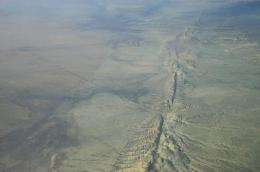Quake prediction model developed

(PhysOrg.com) -- The third in a series of papers in the journal Nature completes the case for a new method of predicting earthquakes.
The forecasting model developed by Danijel Schorlemmer, of the USC College of Letters, Arts and Sciences, aims to predict the rough size and location of future quakes. Testing of the model is underway.
While the timing of quakes remains unpredictable, progress on two out of three key questions is significant in the hard discipline of earthquake forecasting.
Schorlemmer is the senior author of the most recent paper, published online Dec. 3 in Nature. He was the first author of two related papers in Nature, both published in 2005.
"One of the key aspects in forecasting of earthquakes is stresses. The findings in the three papers help identify locations that are highly stressed from readily available earthquake catalogs," Schorlemmer said.
Seismologists believe that the buildup of stress deep in the earth causes earthquakes. Monitoring such stress has proven impossible to date.
Instead, Schorlemmer and his collaborators found a way to estimate the stress indirectly.
They started by observing that different types of earthquakes differ on average in the stresses needed for rupture. Quakes from thrust faults, which push a large block of earth upward, require the largest stress. Quakes on normal faults, in which two plates pull apart and a block of earth drops, require the least stress.
Quakes on strike-slip faults such as the San Andreas, where two plates slide past each other, fall somewhere in the middle.
The researchers then noticed that two laws of statistical seismology - those governing the relative frequency of big and small quakes, and the decay in time of aftershocks - differ slightly for each type of earthquake.
Regions with active thrust faults tend to have a greater proportion of large quakes than regions with normal faults, with strike-slip faults falling in the middle.
The number of aftershocks from quakes on thrust faults tends to start decaying sooner than the number of aftershocks near normal faults, with strike-slip faults again somewhere in between.
Schorlemmer realized that these differences could be applied predictively: One could study the relative frequency and aftershock patterns of small to medium sized earthquakes - which occur regularly in every seismically active region - and infer the level of stress in different parts of that region.
That realization led to a new earthquake prediction model.
The model cannot predict the timing of a quake, but it may be the first to provide an indirect measure of the stress inside the earth, and therefore a reasonable estimate of the size and location of future quakes.
"We are observing the little aftershocks all over California, deriving the state of stress and trying to predict the future mainshocks," Schorlemmer said.
"It's not perfect. It's the only proxy (for stress) we could come up with so far."
The model is now being tested by the Collaboratory for the Study of Earthquake Predictability (CSEP), an international project started by Thomas Jordan, director of the Southern California Earthquake Center based at USC.
"This study provides new insights about how forces within Earth's crust control seismic processes, and we should be able to use this information to improve our ability to forecast earthquakes," Jordan noted.
CSEP is testing several forecast models along with Schorlemmer's. Because the test needs to run at least five years, results are not yet available.
The Schorlemmer group's findings have theoretical as well as practical impact. Seismologists had known for decades about the two laws of statistical seismology governing relative frequency and aftershock patterns, but could not agree on why they worked.
"What is causing them, and why are they what they are? We're now able to relate physical properties to parameters of these two fundamental laws," Schorlemmer said.
Since the first step in predicting the behavior of a system is to understand it, the Schorlemmer group's research should advance the field of earthquake forecasting significantly.
Source: University of Southern California (news : web)
















